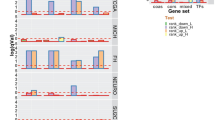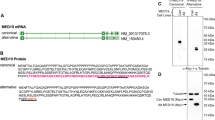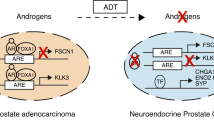Abstract
The use of botanical mixtures is commonplace in patients with prostate cancer, yet the majority of these products have not been rigorously tested in clinical trials. Here we use PC-SPES, a combination of eight herbs that has been shown to be effective in clinical trials in patients with prostate cancer, as a model system to demonstrate ‘proof of principle’ as to how gene expression profiling coupled with promoter assays can evaluate the effect of herbal cocktails on human prostate cancer. In addition, we demonstrate how such approaches may be used for standardization of herbal extract activity by comparing the gene profile of PC-SPES with that of PC-CARE, a product with a similar herbal composition. Since prior studies have shown that PC-SPES contains estrogenic organic compounds, and such compounds are known to affect prostate cancer, an important issue is whether these are the primary drivers of the gene profile. Our data suggest that gene expression profiles of LNCaP human prostate cancer cells in response to PC-SPES are different from those found when diethylstilbestrol (DES), a synthetic estrogen, is used, suggesting that the estrogenic moieties within PC-SPES do not drive this expression signature. In contrast, the expression profile of PC-CARE was almost identical to that of DES, highlighting that mixtures containing similar herbal compositions do not necessarily result in similar biological activities. Interestingly, these three agents cause similar in vitro morphological changes and growth effects on LNCaP. To validate the expression profiling data, we evaluated the protein expression and promoter activity of prostate-specific antigen (PSA), a gene induced by PC-SPES but repressed by DES. In order to gain a mechanistic understanding of how PC-SPES and DES affect PSA expression differently, LNCaP cells were transiently transfected with wild-type and mutagenized PSA promoter, ARE concatemers and appropriate controls. We provide evidence that androgen response elements (ARE) II and III within the promoter region are responsible for the suppressive effects of DES and stimulatory effects of PC-SPES. In addition, we show that the effects on PSA transcription are ARE specific in the case of DES while PC-SPES affects this promoter nonspecifically. In conclusion, expression profiling coupled with mechanistic target validation yield valuable clues as to the mode of action of complex botanical mixtures and provides a new way to compare objectively mixtures with similar components either for effect or quality assurance prior to their use in clinical trials.
This is a preview of subscription content, access via your institution
Access options
Subscribe to this journal
Receive 50 print issues and online access
$259.00 per year
only $5.18 per issue
Buy this article
- Purchase on Springer Link
- Instant access to full article PDF
Prices may be subject to local taxes which are calculated during checkout




Similar content being viewed by others
References
Averboukh L, Liang P, Kantoff PW and Pardee AB . (1996). Prostate, 29, 350–355.
Bonham M, Arnold H, Montgomery B and Nelson PS . (2002). Cancer Res., 62, 3920–3924.
Bubley GJ, Carducci M, Dahut W, Dawson N, Daliani D, Eisenberger M, Figg WD, Freidlin B, Halabi S, Hudes G, Hussain M, Kaplan R, Myers C, Oh W, Petrylak DP, Reed E, Roth B, Sartor O, Scher H, Simons J, Sinibaldi V, Small EJ, Smith MR, Trump DL, Vollmer R Wilding G et al. (1999). J. Clin. Oncol., 17, 3461–3467.
Cleutjens KB, van Eekelen CC, van der Korput HA, Brinkmann AO and Trapman J . (1996). J. Biol. Chem., 271, 6379–6388.
Cleutjens KB, van der Korput HA, van Eekelen CC, van Rooij HC, Faber PW and Trapman J . (1997). Mol. Endocrinol., 11, 148–161.
Darzynkiewicz Z, Traganos F, Wu JM and Chen S . (2000). Int. J. Oncol., 17, 729–736.
de la Taille A, Buttyan R, Hayek O, Bagiella E, Shabsigh A, Burchardt M, Burchardt T, Chopin DK and Katz AE . (2000). J. Urol., 164, 1229–1234.
DiPaola RS, Zhang H, Lambert GH, Meeker R, Licitra E, Rafi MM, Zhu BT, Spaulding H, Goodin S, Toledano MB, Hait WN and Gallo MA . (1998). N. Engl. J. Med., 339, 785–791.
Helps NR, Luo X, Barker HM and Cohen PT . (2000). Biochem. J., 349, 509–518.
Hsieh T, Chen SS, Wang X and Wu JM . (1997). Biochem. Mol. Biol. Int., 42, 535–544.
Kubota T, Hisatake J, Hisatake Y, Said JW, Chen SS, Holden S, Taguchi H and Koeffler HP . (2000). Prostate, 42, 163–171.
Li C and Wong WH . (2001). Proc. Natl. Acad. Sci. USA, 98, 31–36.
Malkowicz SB . (2001). Urology, 58, 108–113.
Montgomery BT, Young CY, Bilhartz DL, Andrews PE, Prescott JL, Thompson NF and Tindall DJ . (1992). Prostate, 21, 63–73.
Oh WK, George DJ, Hackmann K, Manola J and Kantoff PW . (2001). Urology, 57, 122–126.
Schadt EE, Li C, Ellis B and Wong WH . (2001). J. Cell Biochem. Suppl., (Suppl. 37), 120–125.
Schadt EE, Li C, Su C and Wong WH . (2000). J. Cell Biochem., 80, 192–202.
Seraj MJ, Harding MA, Gildea JJ, Welch DR and Theodorescu D . (2000). Clin. Exp. Metast., 18, 519–525.
Small EJ, Frohlich MW, Bok R, Shinohara K, Grossfeld G, Rozenblat Z, Kelly WK, Corry M and Reese DM . (2000). J. Clin. Oncol., 18, 3595–3603.
Small EJ, Kantoff P, Weinberg VK, Nguyen S, Smith MR, Bubley GJ and Oh WK . (2002). J. Clin. Oncol., 21, Abstract #709.
Sovak M, Seligson AL, Konas M, Hajduch M, Dolezal M, Machala M and Nagourney R . (2002). J. Natl. Cancer Inst., 94, 1275–1281.
Takezawa Y, Nakata S, Kobayashi M, Kosaku N, Fukabori Y and Yamanaka H . (2001). Scand. J. Urol. Nephrol., 35, 283–287.
Turner KJ, Morley M, MacPherson S, Millar MR, Wilson JA, Sharpe RM and Saunders PT . (2001). Mol. Cell Endocrinol., 178, 73–87.
White J . (2002). J. Natl. Cancer Inst., 94, 1261–1263.
Wu HC, Hsieh JT, Gleave ME, Brown NM, Pathak S and Chung LW . (1994). Int. J. Cancer, 57, 406–412.
Acknowledgements
The authors thank Drs Jay Fox and Yongde Bao of the University of Virginia Array Core facility for their assistance with chip hybridization, data analysis and helpful suggestions.
Author information
Authors and Affiliations
Corresponding author
Rights and permissions
About this article
Cite this article
Bigler, D., Gulding, K., Dann, R. et al. Gene profiling and promoter reporter assays: Novel tools for comparing the biological effects of botanical extracts on human prostate cancer cells and understanding their mechanisms of action. Oncogene 22, 1261–1272 (2003). https://doi.org/10.1038/sj.onc.1206242
Received:
Revised:
Accepted:
Published:
Issue Date:
DOI: https://doi.org/10.1038/sj.onc.1206242
Keywords
This article is cited by
-
Quantitative analysis of multiple genes’ expressions based on a novel competitive RT-PCR assay
Analytical and Bioanalytical Chemistry (2013)
-
Down-regulation of DcR2 sensitizes androgen-dependent prostate cancer LNCaP cells to TRAIL-induced apoptosis
Cancer Cell International (2011)
-
A comprehensive platform for quality control of botanical drugs (PhytomicsQC): a case study of Huangqin Tang (HQT) and PHY906
Chinese Medicine (2010)
-
Use of complementary and alternative medical therapy by patients with primary brain tumors
Current Neurology and Neuroscience Reports (2008)
-
Expression profiling of Ral-depleted bladder cancer cells identifies RREB-1 as a novel transcriptional Ral effector
Oncogene (2007)



